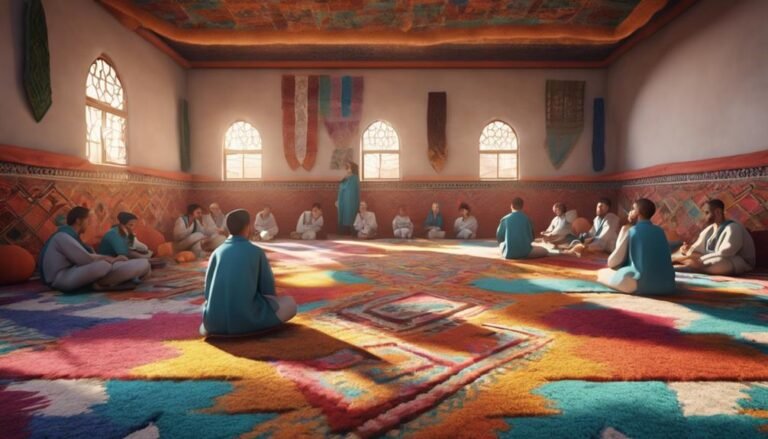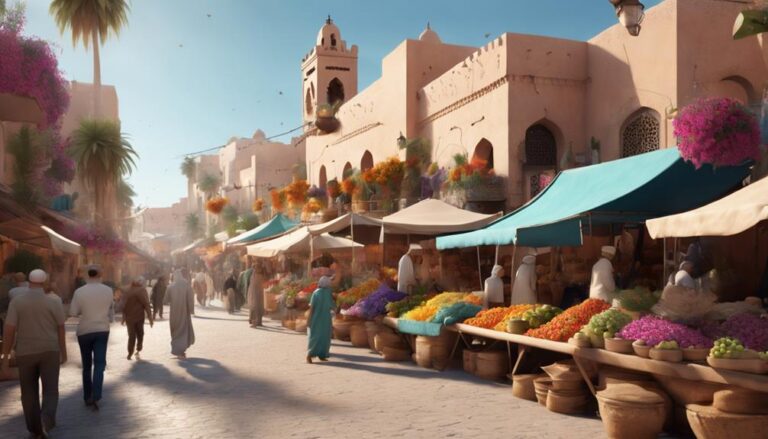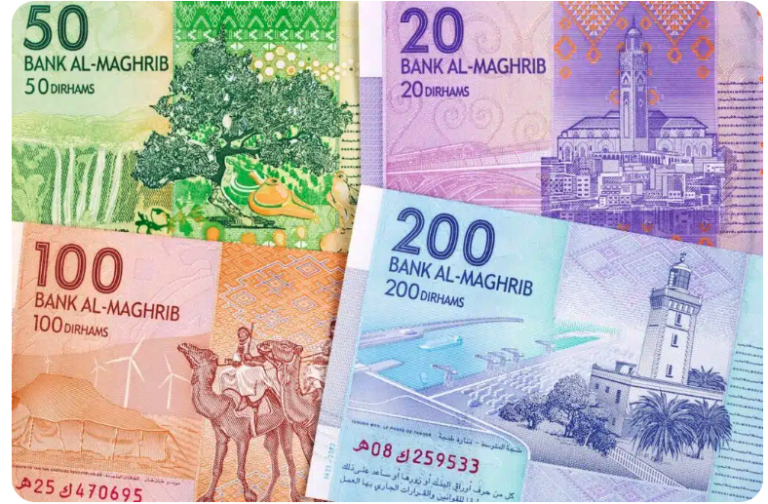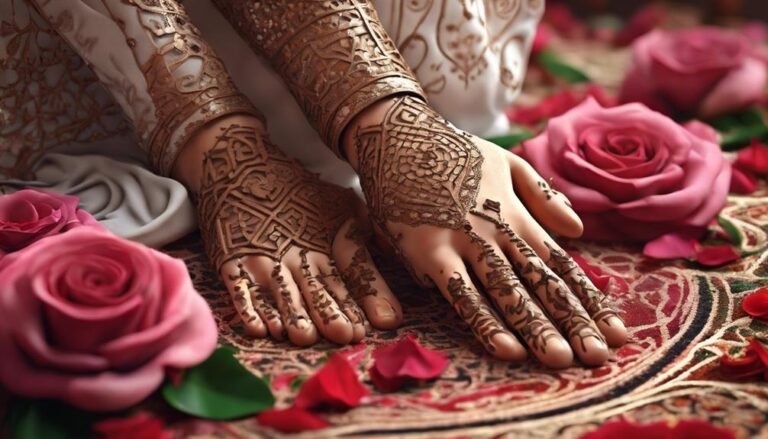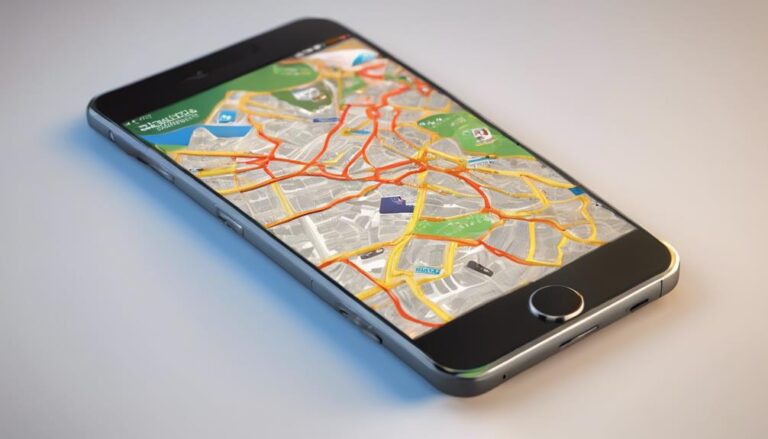Moroccan palaces are exquisite architectural marvels that epitomize Morocco's rich cultural history. They feature intricate carvings, colorful tiles, and ornate archways crafted by skilled artisans using traditional materials like clay and wood. These palaces blend geometric patterns, calligraphy, and lush gardens to create a mesmerizing experience. Symbolizing power and authority, they serve as hubs of cultural exchange. The palatial gardens offer a serene oasis of beauty and tranquility, reflecting Morocco's diverse heritage. The opulent tile work and preservation efforts showcase the country's deep cultural significance. Moroccan palaces truly encapsulate a dynamic convergence of past and present.
Key Takeaways
- Moroccan palaces showcase rich history, cultural fusion, and intricate craftsmanship.
- They feature ornate carvings, colorful tiles, and lush gardens.
- These palaces serve as symbols of power, authority, and cultural exchange.
- Intricate tile work and geometric patterns define their design.
- Preservation efforts balance historical authenticity with modern functionalities.
Origins of Moroccan Palaces
Moroccan palaces showcase the rich history and cultural heritage of the region, highlighting a unique fusion of diverse influences and construction methods. The intricate carvings, colorful tiles, and ornate archways stand as a tribute to the skilled craftsmen who meticulously crafted these palaces using traditional materials like clay, wood, and marble.
The influences on Moroccan palace design can be seen in the harmonious blend of geometric patterns, intricate calligraphy, and lush gardens that create a serene and opulent atmosphere. Construction techniques such as the use of zellij mosaic tile work, carved plaster known as 'gypsum,' and intricate woodwork reflect the attention to detail and craftsmanship that define Moroccan palaces. These architectural marvels serve as a reflection of the rich history and cultural heritage of Morocco, showcasing a unique fusion of diverse influences and construction methods.
Architectural Elements and Design
As you explore Moroccan palaces, you'll be captivated by the intricate carvings and decorative tilework that adorn the walls and ceilings.
These architectural elements showcase the skilled craftsmanship and attention to detail that characterize traditional Moroccan design.
The blend of geometric patterns and vibrant colors creates a mesmerizing visual experience that transports you to a world of opulence and beauty.
Decorative Tilework
What makes the ornate tilework in Moroccan palaces so enchanting and distinctive? Moroccan decorative tilework, known as zellige, is a true reflection of the country's rich artistic heritage. Its intricate patterns and vibrant colors are a feast for the eyes, but there's more to it than just aesthetics. Here are three key points about Moroccan tilework:
- Artistic Techniques: The meticulous craftsmanship involved in creating zellige tiles showcases the mastery of Moroccan artisans, who use traditional methods passed down through generations.
- Cultural Significance: These tiles often feature geometric designs and calligraphy that hold deep cultural meanings, reflecting Morocco's historical influences and religious beliefs.
- Modern Interpretations: While traditional patterns remain popular, contemporary designers are also incorporating modern elements into Moroccan tilework, blending the old with the new.
Intricate Carvings
The intricate carvings found in Moroccan palaces showcase an unparalleled level of craftsmanship and attention to detail in their architectural elements and design. Moroccan craftsmanship is evident in the meticulous carvings that adorn the walls, ceilings, and doorways of these opulent palaces.
These carvings often feature traditional motifs such as geometric patterns, floral designs, and intricate calligraphy, reflecting the rich cultural heritage of Morocco. The skilled artisans behind these carvings use techniques passed down through generations to create stunning works of art that add depth and beauty to the palace interiors.
Each carving tells a story, capturing the essence of Moroccan artistry and serving as a tribute to the country's rich artistic traditions.
Role of Moroccan Palaces in History
With a rich tapestry of architectural marvels, Moroccan palaces have played a pivotal role in shaping the country's historical narrative. These majestic structures have influenced the course of history and continue to hold immense cultural significance. Here are three ways Moroccan palaces have left an indelible mark on the nation's past:
- Symbol of Power: Moroccan palaces served as symbols of authority and power, reflecting the grandeur and prestige of the ruling dynasties throughout history.
- Architectural Heritage: These palaces showcase the intricate craftsmanship and architectural prowess of Moroccan artisans, preserving centuries-old techniques and designs that have stood the test of time.
- Cultural Exchange: Moroccan palaces were hubs of cultural exchange, where artists, scholars, and dignitaries from around the world converged, fostering intellectual and artistic growth that enriched the country's heritage.
Through their role in history, Moroccan palaces stand as affirmations to the country's rich cultural tapestry and serve as reminders of a bygone era marked by opulence and sophistication.
Significance of Moroccan Palace Gardens
When exploring the significance of Moroccan palace gardens, you'll discover a harmonious blend of garden design elements.
These gardens not only showcase intricate water features and lush greenery but also serve as a reflection of Morocco's rich historical influence.
Moreover, the cultural symbolism embedded within these gardens adds layers of meaning and beauty to the overall palace experience.
Garden Design Elements
Incorporating intricate tile work, lush greenery, and soothing water features, Moroccan palace gardens transport visitors to a serene oasis of beauty and tranquility. These gardens are meticulously designed to create a peaceful and enchanting atmosphere.
Some key garden design elements to note are:
- Fountain Features: Moroccan palace gardens often boast stunning fountain features that not only add a touch of elegance but also provide a soothing ambiance.
- Outdoor Seating: Comfortable seating areas are strategically placed throughout the gardens, allowing visitors to relax and immerse themselves in the beauty of the surroundings.
- Plant Selection: Carefully chosen plant varieties, such as citrus trees, jasmine, and roses, enhance the sensory experience and reflect the rich botanical diversity of Morocco.
Historical Influence
The allure of Moroccan palace gardens extends beyond their aesthetic appeal, delving into the historical significance that has shaped their design and purpose. These gardens are a reflection of Morocco's rich history, blending elements of various civilizations that have influenced the region over the centuries.
The historical impact on Moroccan palace gardens can be seen in the intricate tile work, geometric patterns, and traditional craftsmanship that adorn these green spaces. The gardens often feature fountains, citrus trees, and aromatic plants, embodying the country's diverse cultural heritage.
The design of these gardens not only served as a place of relaxation for royalty but also as a symbol of wealth and power, showcasing the opulence and sophistication of Moroccan architecture and design.
Cultural Symbolism
Exemplifying a harmonious blend of cultural symbolism, Moroccan palace gardens serve as vibrant reflections of the country's diverse heritage and artistic traditions. These meticulously designed spaces hold profound cultural significance, capturing the essence of Moroccan identity through symbolism in design.
- Symmetry: Moroccan palace gardens often feature symmetrical layouts, symbolizing balance and harmony in life.
- Water Features: The presence of fountains and water channels represents purity and life, echoing the importance of water in Moroccan culture.
- Botanical Diversity: The variety of plants and flowers in these gardens symbolize growth, renewal, and the beauty of nature, reflecting the rich botanical traditions of Morocco.
Intricate Tile Work in Palatial Design
Among the defining features of Moroccan palatial design are the exquisite and intricate tile work that adorns the architecture. Tile patterns hold deep cultural significance in Moroccan design, often reflecting the country's rich history and traditional art forms. These tiles are meticulously crafted with geometric designs that have been passed down through generations, showcasing Morocco's artistic traditions.
The intricate tile work found in Moroccan palaces often features vibrant colors and intricate patterns that create a mesmerizing visual effect. Each tile is carefully placed to form elaborate mosaics that tell stories and convey symbolism unique to Moroccan culture. The geometric patterns not only add to the aesthetic appeal of the palaces but also serve practical purposes, such as providing ventilation and maintaining a cool interior temperature.
The attention to detail in the tile work highlights the craftsmanship and mastery of Moroccan artisans, making it a cornerstone of the country's architectural identity.
Modern Influence and Preservation Efforts
To understand the impact of modern influences on Moroccan palaces and the ongoing preservation efforts, it's essential to explore how contemporary design trends intersect with traditional architectural practices. In Morocco, the architectural evolution of palaces faces preservation challenges due to the delicate balance between retaining historical authenticity and integrating modern functionalities.
- Preservation Challenges: The delicate restoration process of Moroccan palaces requires expertise to maintain the original beauty while ensuring structural integrity.
- Architectural Evolution: Modern architects are incorporating sustainable materials and energy-efficient technologies into palace renovations to align with contemporary environmental standards.
- Cultural Heritage Conservation: Preservation efforts aren't only about physical structures but also about safeguarding the intangible heritage embedded in Moroccan palaces, such as traditional craftsmanship and design motifs.
These factors contribute to the dynamic landscape of Moroccan palaces, where the past and present converge in a delicate dance of preservation and innovation, shaping the future of these architectural marvels.
Conclusion
You've now learned about the beauty and history of Moroccan palaces.
Did you know that the largest palace in Morocco, the Royal Palace of Casablanca, covers an impressive 175 acres of land?
Imagine walking through its grand halls and sprawling gardens, feeling the rich history and culture surrounding you.
Moroccan palaces truly are a sight to behold, blending intricate design with centuries of tradition.
Explore these architectural wonders and discover the magic of Morocco.

The Editorial Team is a passionate group of Morocco enthusiasts dedicated to sharing the beauty, culture, and wonders of this captivating country. With diverse backgrounds and a deep love for travel, we strive to bring you engaging and informative content that inspires your Moroccan adventures. From uncovering hidden gems and sharing local insights to exploring mouthwatering cuisine and showcasing the vibrant lifestyle, our team is committed to providing you with valuable resources and exciting stories that enhance your exploration of Morocco. Join us on this journey as we celebrate the rich heritage and unforgettable experiences that make Morocco truly special.


